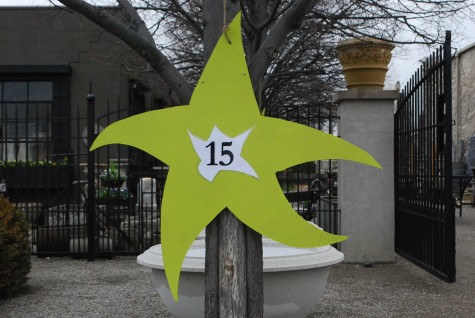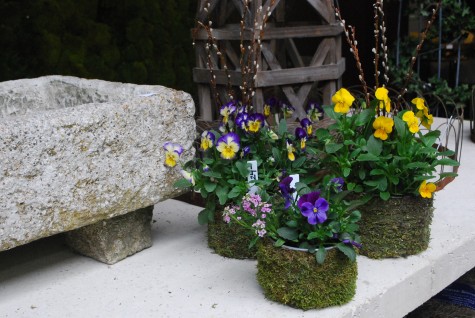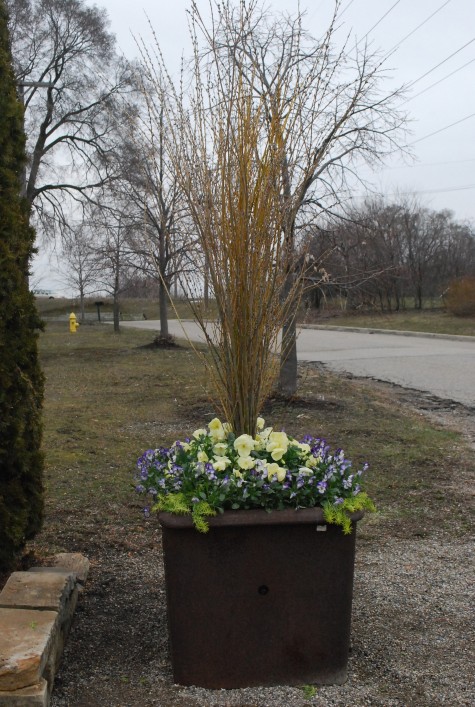 Our very first spring garden fair, in celebration of the 15th anniversary of Detroit Garden Works, is this weekend. I do feel a little sheepish, making such a fuss about having become a teenager. But the optimism that comes naturally to a gardener is a pretty big umbrella. As much as I expect that the brown bulbs I planted last fall will eventually produce plants with gorgeous flowers, I expect to keep on providing the gardening community with a place that respects their interest. I am pleased with our teenage history. We hung lime green dancing stars in the lindens today-recycled from a fundraiser we did for the Children’s Center in Detroit some years ago. The mission of the Children’s Center is to help educate kids, and encourage them to work hard and do well. Their efforts are aimed at helping kids to be properly equipped to have productive lives that make a contribution to their community. This optimism I like.
Our very first spring garden fair, in celebration of the 15th anniversary of Detroit Garden Works, is this weekend. I do feel a little sheepish, making such a fuss about having become a teenager. But the optimism that comes naturally to a gardener is a pretty big umbrella. As much as I expect that the brown bulbs I planted last fall will eventually produce plants with gorgeous flowers, I expect to keep on providing the gardening community with a place that respects their interest. I am pleased with our teenage history. We hung lime green dancing stars in the lindens today-recycled from a fundraiser we did for the Children’s Center in Detroit some years ago. The mission of the Children’s Center is to help educate kids, and encourage them to work hard and do well. Their efforts are aimed at helping kids to be properly equipped to have productive lives that make a contribution to their community. This optimism I like.  I spent the day attending to all the last minute details. Of course we have a few cut flower arrangements. After all, this is a party.
I spent the day attending to all the last minute details. Of course we have a few cut flower arrangements. After all, this is a party.
 Most of my pots of bulbs planted last fall are still green; the spring has been very slow in coming. But outside, there are signs of life. My crocus patches at home are beautiful right now. The weekend promises warm weather-the first we have had in many months. No gardener will fault me for my green foliaged bulb pots-they understand that nature is a big fluid situation. They will come back for the show-that date is yet to be announced.
Most of my pots of bulbs planted last fall are still green; the spring has been very slow in coming. But outside, there are signs of life. My crocus patches at home are beautiful right now. The weekend promises warm weather-the first we have had in many months. No gardener will fault me for my green foliaged bulb pots-they understand that nature is a big fluid situation. They will come back for the show-that date is yet to be announced.
 I will admit that many of the spring containers I planted up for this event have been in a greenhouse for some time. Spring in Michigan can be so variable. Last year, the spring was early, and moderate. It might have been the most beautiful spring that has ever been my pleasure to witness. This spring-where is it? I think it might be arriving tomorrow. We have a great weather forecast for the weekend.
I will admit that many of the spring containers I planted up for this event have been in a greenhouse for some time. Spring in Michigan can be so variable. Last year, the spring was early, and moderate. It might have been the most beautiful spring that has ever been my pleasure to witness. This spring-where is it? I think it might be arriving tomorrow. We have a great weather forecast for the weekend.
 I have planted lots of containers at the shop, and all of the window boxes- just for spring. Though our spring has the potential to last only days, I prefer to focus on the potential part. The only days part-I refuse to be bullied.
I have planted lots of containers at the shop, and all of the window boxes- just for spring. Though our spring has the potential to last only days, I prefer to focus on the potential part. The only days part-I refuse to be bullied.

I am not willing to give up planting pansies and violas over a worry about how many days they might last. I am optimistic that everyone will benefit from a big dose of spring-I know I do. What nature delivers to its winter weary population is welcome at my place.
 Lettuce in flats-the promise of the good that is to come. Should you read this blog regularly, you know I plant lettuce in pots as it is beautiful. I am not much of a vegetable gardener. But I do eat lettuce most every day. On those days when Buck is too tired to make a salad, he’ll fix me a mess of greens, and dress them. Like most gardeners, I need the greens.
Lettuce in flats-the promise of the good that is to come. Should you read this blog regularly, you know I plant lettuce in pots as it is beautiful. I am not much of a vegetable gardener. But I do eat lettuce most every day. On those days when Buck is too tired to make a salad, he’ll fix me a mess of greens, and dress them. Like most gardeners, I need the greens.

Vernissage is a French word referring most usually to the opening of an art exhibit. It was the title of my first blog post April 1 of 2009. Spring-it is the opening of an art exhibit that will go on and enchant for the next 7 months. I hope to see you at the opening. Should you live far away-we still have a community. I will keep you posted. I hope to hear from you. Gardeners everywhere are about to celebrate spring. Come round, should you have the chance.